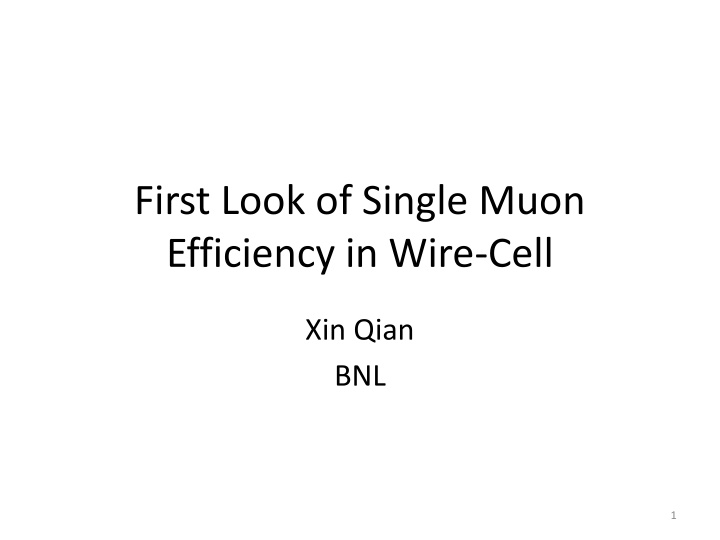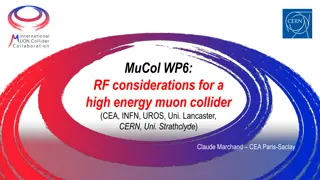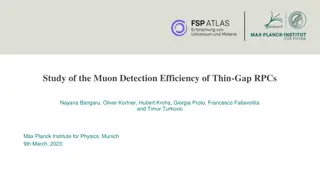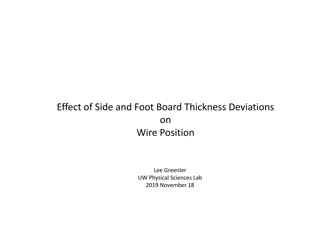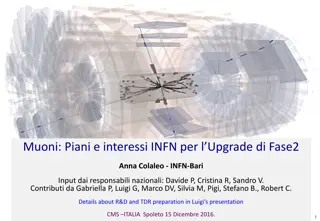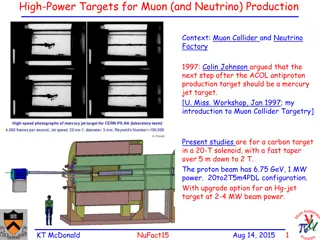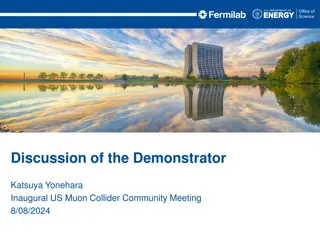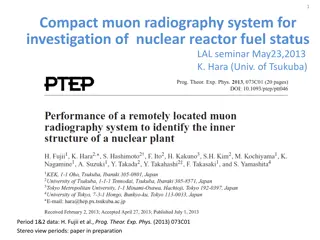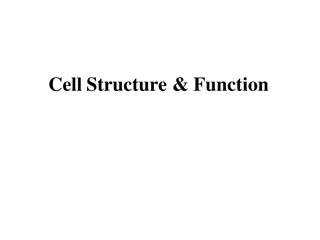Insights into Muon Tracking Efficiency in Wire-Cell Research
Explore the evaluation of single muon efficiency through detailed simulations in the Wire-Cell project. Discover advancements in track merging algorithms and the calculation of tracking efficiency using various variables. Dive into the challenges and progress in muon tracking within detector limitations.
Download Presentation

Please find below an Image/Link to download the presentation.
The content on the website is provided AS IS for your information and personal use only. It may not be sold, licensed, or shared on other websites without obtaining consent from the author.If you encounter any issues during the download, it is possible that the publisher has removed the file from their server.
You are allowed to download the files provided on this website for personal or commercial use, subject to the condition that they are used lawfully. All files are the property of their respective owners.
The content on the website is provided AS IS for your information and personal use only. It may not be sold, licensed, or shared on other websites without obtaining consent from the author.
E N D
Presentation Transcript
First Look of Single Muon Efficiency in Wire-Cell Xin Qian BNL 1
Recap of Wire-Cell Details of principle and status can be found in the recent wire-cell summit: https://indico.physics.lbl.gov/indico/conferenceDispla y.py?confId=258 Basic steps: Wire-Cell Imaging Good shape Wire-Cell Pattern Recognition (Still) in progress Wire-Cell Fine Tracking Not yet implemented Will based on existing work (PMA, PID ) 2
Evaluation of Single Muon Efficiency Simulation details: MicroBooNE geometry (MCC6.1) ~10k isotropic single muon from 0.1-2.0 GeV Not just straight lines, physics process are on (i.e. multiple scattering, muon decay) Pattern recognition details: Based on existing work on pattern recognition Track ID, vertex fitting, shower identification Newly developed track merging alg. Tracking is still limited inside the connected clusters 3
Newly Developed Track Merging Before Merging After Merging In the existing pattern recognition, if there is a vertex connecting three (or more) lines, each line will be identified as a track no matter its property In the newly developed merging alg., tracks can be merged together according to their (matched) angle, (matched) distance 4
MC Truth For muons traveling at a very long distance, there is a correlation with its angle due to limitation of the detector size 2.3(H) x 2.56 (D) x 10.x (L) 5
Calculation of Efficiency Only muon tracks were studied Still works to do to properly deal with deltas for merged tracks Three variables are used to evaluate muon tracking efficiency: Distance between true starting point and reconstructed track s end point Distance between the recorded true end point near the detector boundary and the reconstructed track s end point Points along the true track were saved at every ~5 cm? Length of the true track and reconstructed track 6
Distributions Default cut position is indicated by the lines Note: for the ending points, when the muon tracks travel out the detector volume, we did not calculate the precise ending point, so there is a larger spread For small reco/true ratio, likely tracks are not totally merged together For large reco/true ratio, picked up the michel part, also imprecisions in track length calculation due to lack of fine tracking 7
Efficiencies (I) Two criteria for good tracks: 1. Starting points matched < 2 cm && ending points matched < 5 cm 2. (Starting points matched < 5 cm || ending points matched < 10 cm) && abs(Lreco/Ltrue-1)<0.2 Also tried abs(Lreco/Ltrue-1)<0.5 Cuts Events Inefficiency None 9273 N/A 1+2 (0.2 cut on length ratio) 8943 4.6% 1+2 (0.5 cut on length ratio) 9158 1.2% 8
Efficiencies (II) Worse performance for tracks that are parallel to the wire planes (0, 180 degrees) These tracks tends to be long tracks Merging algorithms needs to be improved (see next slides) 9
Some Failed Cases (I) Gaps http://www.phy.bnl.gov/wire-cell/bee/set/c684fbcd-5386-422f-90d9- 56d3e21ad44e/event/0/ There are gaps existing in the images due to simulations Gaps lead to separated clusters, good tracking within a cluster Algorithms to stitch tracks from separated clusters not yet developed 10
Some Failed Cases (II) http://www.phy.bnl.gov/wire- cell/bee/set/d35d3ec2-ad07-4b44-a8d7- 01f4e3c1c029/event/0/ A large angle scattering, event was identified as shower (shower ID alg. needs to be improved) If shower ID is forced to be false, several tracks including michel electrons are IDs 11
Next Steps Put results back to LarSoft and use the standard algorithm to calculate efficiency for comparison Need to properly deal with the left-over merged cells in the track merging steps Need to develop higher level objects to handle not-connected clusters Needed to identify shower Needed to stitch tracks Needed to deal with gaps in real detectors (special since we know the dead region) Improve Alg. to deal with real gaps due to unusable channels 12
Summary We performed the first look of tracking efficiency for (isotropic + wide momentum range) single muons from wire-cell Results are promising Further improvements are expected Development of pattern recognition is still on- going and is in good progress Will move into fine tracking soon (PMA, PID, energy, angle, event ID, neutrino selection ) 13
